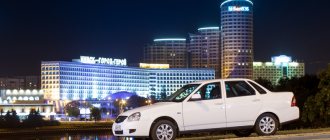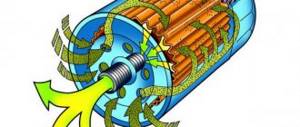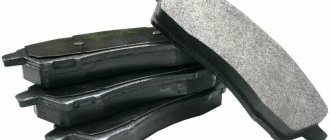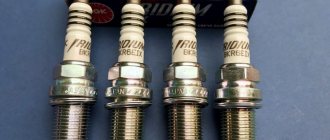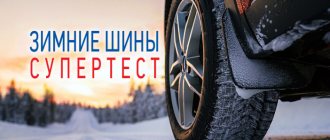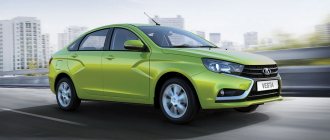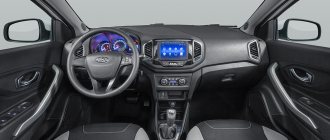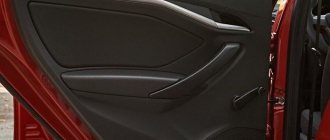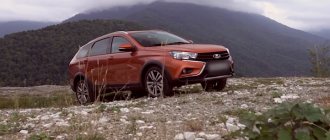Life tests make it possible to identify weaknesses in a vehicle’s design in a short time. Several thousand kilometers in this mode are comparable to tens of thousands in real ones. The Lada Vesta sedan previously passed a similar test; now it’s the turn to test the reliability of station wagons (Lada Vesta SW and Lada Vesta SW Cross).
Autoreview
It is beautiful, but not cheap, handles well, but accelerates poorly, practical, but voracious.
Suspension
:
- The suspension of the Lada Vesta SW and Lada Vesta SW Cross is different. On the cross version it is more “asphalt”.
- The suspension is denser, reactions are faster and more accurate, with it Vesta Cross rolls less and sways less.
- But it emphasizes waves and irregularities more strongly.
Control
:
- The elevated Cross controls more accurately and tastes better.
- The cross costs 830 thousand, but drives like a million. Reactions are fast and accurate, rolls are almost not felt.
Clearance
:
- Ground clearance is 203 mm - Crete never dreamed of this, and Kaptur is only one millimeter higher, but from experience there is more confidence in the Lada's passport clearance.
Noise insulation
:
- Unexpectedly good sound insulation (in a station wagon it is almost quieter than in a sedan).
- The roar of the engine is insipid, the turn signals click poorly, the horn snarls in the voice of a cold teenager.
Body:
- The rigidity of the station wagon body compared to the sedan dropped by only 100 Nm/deg and amounts to 17900-18900 Nm/deg. To compensate for the lack of a rigid rear shelf, the design has several additional elements that strengthen the body.
- We hung one wheel, all doors open and close without problems.
Fuel consumption
the Cross version in mountainous areas floated from 12 to 14 liters per 100 km.
Link #1 and link #2 for a test drive.
Prices and options
Lada Vesta can be enjoyed in three trim levels - Classic, Comfort and Luxury.
1.6 MT Classic - price 555 thousand rubles.
The standard equipment of the Lada Vesta, meanwhile, includes many interesting things. The interior comes only with fabric upholstery, there are five headrests, the second row of seats can be solid or separate. Among the electronic equipment, it is worth noting the remote key, central locking system, automatic windows, temperature control of seats, mirrors and windshield. A total of 26 setup programs. The developers hint that the Lada Vesta Cross will be even better equipped.
The safety system is equipped with airbags for passengers, three-point seat belts, automatic door locking when driving and child protection, child seat mounts, an alarm, an immobilizer, a brake light on the rear window and the GLONASS system.
Also included are halogen headlights, special rear fog lights, an audio system with four speakers, a spare tire, and external lighting devices.
For comfortable and safe driving, there is a dynamic stabilization system, a hill assist system and an electro-hydraulic brake booster system for emergencies.
1.6 MT Comfort - price 607 thousand rubles.
In addition to the standard version, there is an extended trim for the front seats with an armrest, a ventilated glove compartment, rear parking sensors, air conditioning, radio, AUX, USB, MP3, and a hands-free device. Side mirrors and door handles match the color of the entire car.
1.6 MT Luxe — 670 thousand rubles.
In addition to the standard equipment, there are front fog lights, a light sensor, additional functions in the front seats, and a front armrest. There are power windows in the rear and airbags in the doors. For the driver's convenience, there is also a ventilated glove compartment, rear parking sensors, climate control, audio system control from the steering wheel, AUX, USB, SD card slot, MP3 support, hands free, lighting with door open sensor, rain sensor, windshield temperature maintenance , container for glasses.
You can also order additional packages from your dealer:
- Image package - price 23 thousand rubles. It includes automatic rear door windows, a spare tire, and windshield temperature control.
- Multimedia package - price 64 thousand rubles. It includes a light sensor, an audio system control unit on the steering wheel, cruise control, climate control, a multimedia system, six speakers instead of four, an SD card slot, a navigator, a monitor, a rearview camera, and lighting with a door sensor.
- Start package - price 15 thousand rubles. It includes a ventilated glove compartment and air conditioning.
- Start 6FD package - for 10 thousand rubles. less. The client receives a ventilated glove compartment and air conditioning, but there will be no rear fog lights, electric heating and electric side mirrors, as well as electric heated front seats.
- Optima package - price 9 thousand rubles. less. The client receives aluminum wheels instead of decorative caps, plus a heated windshield.
- Lime package - price 5 thousand rubles. The customer receives the car's Lime color, but without the rear fog lights.
Recommended article: Tuning the Lada Kalina looks unusual
These are the basic packages that most dealerships will offer you. There are many other original packages; availability and prices should be checked directly with dealers. By selecting additional packages, you can reduce the cost of the classic package and bring it almost to the state of the most expensive. Absolutely everything is adapted for the convenience of clients.
Behind the wheel
Suspension
:
- The regular Vesta SW station wagon has a rear suspension exactly like a sedan, but the characteristics of the springs and shock absorbers have been slightly revised for higher loads.
- Cross has different springs: thanks to them, the ground clearance is increased from 178 to 203 mm.
- This is the first production Lada with suspension like Subaru!
- There was not even a hint of a breakdown on any of the asphalt waves and holes that abound on the narrow mountain road to Solohaul (a famous rally stop!).
Engine and transmission
:
- The combination of a 122-horsepower engine and a manual transmission is fire! There is always enough engine, although there are three passengers in the car besides me and some luggage.
- The clutch does not require filigree footwork: you just release the pedal and go.
- Only occasionally did a slight itch irritate me, but this, as the engineers assured me, was a consequence of the fact that the engine calibration had not yet been completed.
Control
:
- The strength of the Cross is also that it handles perfectly - better than a sedan.
- ESC is triggered later than on a sedan, allowing you to drive a little more actively and slide longer without the intervention of an electronic guard (due to the fact that ESC is triggered, among other things, by the steering angle sensor + low-profile tires).
- Low-profile tires, with a stiffer sidewall, so when turning the steering wheel you deflect at smaller angles - the car changes course more readily and turns more actively into turns than on higher and softer tires.
- Active drivers will like it - you can afford a little more than usual. Living machine!
Brakes
:
- For ESP operation, disc brakes are preferable: they are faster, especially on rough roads.
Body
:
- The torsional rigidity of the body (on an empty car) is sufficient. The rear right wheel is a couple of millimeters off the ground, but all the doors, including the trunk, open easily.
Link to test drive.
Salon and interior of Lada Vesta
When entering the interior of the Lada Vesta, you immediately pay attention to the new design of the door handles - now there are no unnecessary problems, the door opens with one easy movement. The seals on the doors also took some time to figure out. It was necessary to carry out a lot of tests and eliminate a huge number of shortcomings before the seals began to provide a good level of noise insulation and tightness of the interior.
The steering column and the panel around it are primarily pleasing to the eye. Everything is so interestingly arranged that controlling the car and additional functions becomes intuitive at first glance, despite their abundance.
On the central panel of the Lada Vesta there are connectors for connecting a flash drive and a telephone.
On the steering wheel in the luxury version you can see control units for the audio system and cruise control. The light control is hidden on the left under the steering wheel, and there, but on the right, is the windshield wiper control lever. There is a vertical locking function for the wipers for easy replacement. They clear most of the windshield and provide a clear view.
The manufacturers equipped the driver's seat with the ability to adjust not only back and forth, but also in height. This is the first of the Ladas in which the seats can be adjusted in two dimensions.
Vesta's steering column is also adjustable in height and length, which allows you to completely ergonomically customize the driver's seat. Among the disadvantages: in a certain position, the steering wheel rim can cover the sensors, but this problem also exists in many foreign cars.
Recommended article: Tuning a penny (VAZ 2101) is an expensive and interesting business
The interior of the Lada Vesta was not only equipped with additional functions, but also thoroughly worked on its convenience for passengers and the driver. We started with the simplest thing - expanding the interior area. We have improved the design of seats and headrests, now they anatomically correctly support the lower back and head, and prevent the development of diseases characteristic of people with a sedentary lifestyle.
The electronic control in the Lada Vesta generally works wonders - sometimes it seems that with a slight turn of the lever in this car you can control literally everything!
In particular, the driver’s life is made easier by electric heated seats and windshield, electronic control of side mirrors, built-in navigator and much more.
As a result, the comfort of the cabin pleases even on long trips - the body does not become numb, there is no need to make a lot of unnecessary movements, everything is at hand. The interior upholstery in Vesta is selected according to the client’s wishes, but only from fabric.
Auto.mail.ru
Engine
:
- “Vesta” with the flagship engine (1.8 l, 122 hp), to put it mildly, did not please. In the mountains below the engine is empty, at the top it’s sad, the middle is so-so - no matter what speed you hold, sometimes the car not only didn’t want to accelerate on the climbs, it demanded to switch to a downshift. It’s doubly stressful to crawl along a country road - you have to play with the clutch like a jewel.
- In the morning, the cold engine upset me a couple of times with unexpected drops in traction.
Fuel consumption
:
- In mountainous areas, consumption was 12-13 liters of 92 gasoline. The on-board computer never showed anything below 9 liters the entire time.
Transmission
:
- I liked the Renault JR5 manual transmission: it shifts quite clearly, easily, does not buzz or howl.
Control
:
- Lada Vesta SW. This version resembles a sedan in its behavior on the road. The steering wheel is just as tight, with excitement it turns into a turn when releasing the gas and pleases with a lively response to steering turns.
- Lada Vesta SW Cross turned out to be even more interesting! The “off-road” version did not become any more rolly, retained an acceptable ride on low-profile 17-inch wheels, and even benefited in handling: the “Cross” has a cleaner steering wheel, a richer force on it, and the car is more stable in an arc during a turn.
- On the serpentine road, the front tires of the Cross were rubbing against the support cups of the suspension springs. We hope this is an isolated problem with our car.
- Never before have Russian station wagons driven so deliciously.
Link to test drive.
AutoVesti (Pavel Bludenov)
pros
:
- The suspension works great, the car is truly designed for Russian roads. Absorbs bumps well (better than Renault Kaptur).
- Excellent handling, even on bad roads.
Minuses
:
- Acceleration to 100 km/h is not impressive.
- The new instrument panel is blind, nothing is visible on it.
- AMT is not designed to be used.
- Multimedia system (the sun glares a lot and slows down).
- Below and above the engine behaves sadly.
- In 5th gear up a small hill the car does not accelerate at all.
Overall, the Lada Vestra SW turned out quite well. SW Cross seemed worse than a regular station wagon.
Be careful with the selector!
On the highway, the car's directional stability is not high, and the steering wheel is "indistinct". It seems that he is slightly unable to keep up with the wheels: they have already swerved to the side, and the steering wheel deviates a little later. Gusts of strong wind add to the severity of the situation; sometimes the car simply moves in a sinusoid, albeit within its lane. I look closely at my colleagues in the movement: few, apparently, experience the same problems.
The advertising brochure promises that Vesta will isolate riders from excess noise outside. How to say... Sometimes I hear a strange periodic rustling noise from under the wheels, as if the tires find themselves on sections of asphalt of varying roughness. I am gradually realizing that the sound occurs when the tires touch the markings. Since they are clearly audible, we can conclude that the sound insulation of the interior of the VAZ new product is not so good.
What about your own sounds? Their car also produces a lot. The hum of the windshield washer motor readily penetrates into the cabin. The engine's operation becomes audible to the driver already at approximately 3000 rpm. The box is also not silent - it howls slightly. And how many “crickets” are there behind the interior trim panels! Their main colonies live behind the dashboard and inside the driver's door. They are awakened to life not only by road irregularities, but also by loud music.
But that would be okay. If I owned Vesta, I would not be lazy, dismantle the doors and destroy at least some of the “insects”, gluing in places additional noise and vibration insulating linings. But what to do with the annoying signal that starts beeping when you reach 120 km/h? Let's not pretend to be righteous and claim that we only drive within the official speed limits. 120 is not a speed for modern cars, especially on open, well-cleared and highly visible highways away from populated areas. Vesta is no exception. Secretly from the observant traffic police, I accelerated the car to 150 km/h. At such a speed, the sound of the warning signal, of course, was drowned in the general noise, as well as in the sounds of music. But you can’t drive like that anywhere, ever. And we often exceed 120 km/h when overtaking. So this signal is frankly annoying on long trips.
Our test included a 1.6-liter version of Vesta with a capacity of 106 hp. With. with automatic transmission. The problems with AMT operation on the VAZ sedan are the same as on the Xray crossover. In the same way, the box seems to “sigh” before shifting up the gear. When driving slowly in traffic jams, this is not noticeable - in fact, because the movement occurs in one gear, first or second. The situation is much worse when the car is required to “shoot”, an intense jerk forward. For example, you need to fit into the flow when leaving the yard or from a secondary road to the main one. At the most crucial moment, AMT can “fail,” and this is very unpleasant.
At high highway speeds, shifts are not accompanied by “sighs” - they simply don’t have time. AMT quickly goes through all the stages and stops at the highest - the fifth. If acceleration is necessary, kick-down is triggered and one stage is reset, also without a noticeable “failure”. But take the risk of accelerating more intensely. If you reset two gears at once, there will be such a delay that it may seem as if the AMT is completely stuck. Imagine that when accelerating in a manual car, you press the clutch pedal at the peak of acceleration... Vesta demonstrates something similar.
Autonews
Engine
:
- The new 1.8 liter engine is not very impressive on a mountain road. Vesta goes up strained, requiring a lower gear, or even two.
Transmission
:
- Well adjusted clutch. Everything works without vibrations.
- The gear ratios are also well chosen. The first two gears are well suited for city traffic, while the higher gears are good for highway driving and are economical. Vesta 1.8 drives confidently and accelerates well in the mid-speed zone, but is not distinguished by either powerful traction at the bottom or cheerful spin at high speeds.
Control
:
- A dense, slightly synthetic steering wheel, insensitive at small turning angles, modest rolls and understandable reactions, thanks to which you want and can drive the car along the Sochi serpentines.
Suspension
:
- Due to the redistribution of weight, the characteristics of the rear suspension have changed slightly (the rear springs of the station wagon have been increased by 9 mm), but this is not felt while driving.
- If the standard station wagon handles unevenness and bumps, albeit noticeably, but without crossing the line of comfort, then the Cross’s setup is clearly more asphalt.
- The Cross jumps over rocks without any suspension breakdowns. The standard SW is a little more comfortable in these conditions, but requires a little more careful choice of trajectory (since the ground clearance is lower).
Link to test drive.
Journalists and experts from Autoreview conduct a resource test: Lada Vesta and Lada XRAY.
They say the future approaches much faster if you meet it halfway. This is roughly what we are doing at Autoreview now. I am located near our technical center at the Dmitrovsky Automotive Test Site, and next to me is the Lada XRAY and Lada Vesta. Both undergo accelerated life tests "Autoreview". Why did I talk about the future? Yes, because both cars will have to travel about 32,000 kilometers along the varied roads of the test site, but the load on them will be such that one kilometer is equivalent to three kilometers of normal everyday use, that is, in 4-5 months we will simulate about five years of their life and hundred thousand mileage.
Corrosion tests of Lada Vesta
The second no less important part is corrosion testing. On the body of each car, on each body element, three calibrated cuts of paint are applied: one deep to the metal, the second to the ground, and the third imitates a small scratch.
Why is this done? The cars will spend about 6-10 hours in the salt spray chamber and we'll see how their body feels in five years. We don’t yet have any questions about the Lada XRAY, from the point of view of the corrosion resistance of the body, but I can’t say the same about the Vesta. The deepest cut of the paint (the one that goes deep into the metal) rusted after the first visit to the corrosion chamber, after six hours spent in salt fog, and after the second visit we found rust in the second cut (the one that goes to the ground).
But I must say that on the remaining body elements all the cuts feel great and there is no corrosion anywhere else yet. The same, again, cannot be said about the condition of parts under the hoods of cars and underneath cars. Let's see what the salt has done under the hood. The cars didn’t spend much time in the corrosion chamber, so I don’t see any crime, but elements such as mounting brackets, clamps or the battery bar are quite seriously corroded, and we see the paint peeling off, so in the future the picture will only get worse.
And as for the Lada XRAY, it has about the same picture under the hood. Let's see what we have underneath the car. I see traces of corrosion on the brake drums, on the exhaust system elements, on the rear suspension beams, on the front wheel drives (they are quite rusty). If we remember about the LadaXRAY, the picture below is about the same. The only difference that Vesta has that is not the best is that there is corrosion in the chips on the spar.
Life tests of Lada Vesta and Lada XRey
By the way, both cars have already covered 8,000 kilometers, that is, about a quarter of the distance, and we already have the first results. Vesta has problems with fastening the exhaust part. At 6,200 kilometers, the front mount broke, then knocking noises began to be heard from the rear, and we discovered that the muffler mounting bracket had fallen off and had to be welded into place. And at about 8,000 kilometers, that is, quite recently, we discovered that the middle suspension of the exhaust tract had also torn.
Once Vesta almost lost her driver, and this is how it happened: if you open the door handle so that it moves back a little, then the handle sticks in this position, and the door pretends to be, but does not lock. Moreover, this problem occurs not only with the driver’s door handle, but also with the other doors. Be careful!
We have even more questions for the Lada XRAY; they are all concentrated under the hood and began to appear even before the start of the test run. When the odometer showed only 43 kilometers, a problem arose with the generator: a nut was unscrewed from its shaft, a pulley was lost, the belt came off, and the car had to be sent back to the dealer by tow truck, where the generator assembly was replaced. Then the expansion tank of the cooling system leaked and leaked along the weld seam.
We soldered it, but it didn’t last long, we had to buy a new tank. This is not only a problem with our car; about 1,300 cars have defective tanks, and if the owners contact us, they will be replaced under warranty. But the saddest thing is that there are questions about the newest VAZ 1.8 engine. When operating for a long time at high speeds, about 5,600, the checkengine signal turns on, misfires appear and the engine begins to simply stall. Naturally, we told VAZ engine engineers about these problems, and now a new engine control program is being developed. Most of the mileage is on the highway. In total, both cars will spend 20,000 kilometers here.
Now we are driving a Lada Vesta, its maximum speed is about 185 km/h. The car will go part of the way simply at maximum speed, part with engine braking, part with braking of the service brake system.
As you can see, I am not alone in the salon. Almost half of the run will be carried out with me by three water-filled dummies, weighing 75 kilograms each, and ballast in the trunk - 50 kilograms of lead shot in bags. If a high-speed road primarily affects the engine, acceleration and braking affects the transmission, then a cobblestone road, of course, affects the suspension and the driver. For example, in the XRAY the steering wheel hits your hands a lot, but in the Lada Vesta you need to follow the succession of waves of the coating, the karma jumps great, right up to a short circuit on the bump stop, and the greater the load, the more pronounced this is. Now I’m driving an XRAY, almost the entire cabin is talking: the dashboard, glove compartment, door trims are creaking. And there is an interesting point that on the biggest bumps the wipers turn on by themselves, the lever jumps to the position where they are turned on, which is what happened now, for example. Cars will travel 2,000 kilometers on a mountain road. The speeds here are lower than on the expressway, 100 km/h on straights, 60 km/h in corners, we save the tires. On descents we brake with the engine and accelerate with the pedal to the floor. The cars behave quite predictably even with a full load; we don’t have any special comments about them here. And every 100 kilometers we go up a 10% hill in reverse, loading the reverse gear, and at the same time the clutch. The name of the exercise “Acceleration - Braking” speaks for itself - this is the most intense acceleration in each gear, then engine braking in the opposite direction and stopping using the standard braking system. Here we load both the brakes and the gearbox as much as possible. And it must be said that during the previous endurance tests in which the Lada Granta car took part, the manual transmission failed, we repaired it. The French box on the Lada Vesta feels good so far, as does the robot on the Lada XRAY. The run on dirt roads is not too long, only 400 kilometers, the shortest exercise. And here we look at how the car body resists dust and dirt. Yes, I almost forgot, in addition to the main running part of the test and the corrosion chamber, we conduct so-called additional tests, that is, we slam the trunk lids hundreds of times, fold out the rear seat backs, adjust the front seat, raise and lower the windows, adjust the mirrors, slam everything without exceptions are doors. That is, we do everything that happens to a car body in three to five years. And the accelerated life tests are completed not by a laurel wreath and champagne, but by a crash test, but not at high speed, but at only 15 km/h, the so-called insurance crash test or crash test according to the Danner method. Its result is the cost of restoring a car after a minor urban accident. And at the very end we summarize the main financial results of all tests.
Motor.ru
Engine
:
- According to the passport, thrust, far from the record 170 Nm, comes only to 3700 rpm, and up to 2000 the engine frankly sleeps. When driving up a small hill, we push the gearshift lever one, or even a couple of steps lower, and only after that we move on.
Transmission
:
- The gear lever is a bit long and not very clear.
Fuel consumption
:
- Consumption of 92 gasoline is 11-13 l/100 km.
Salon
:
- On the Vesta SW, the hard plastic on the door armrests will still rub your elbows when resting on them. But “Cross” masterfully knows how to hide all this behind an excellent design.
Link to test drive.
Let us remind you that AvtoVAZ previously talked about the features of the station wagon’s interior and trunk. This car uses a number of technical solutions that have not previously been widely used on LADA. And yet, this car has no direct competitors.
Keywords: Lada Vesta Cross
4
0
Found an error? Select it and press Ctrl+Enter..

